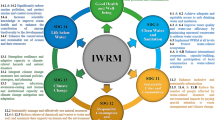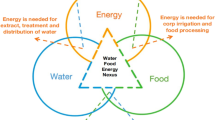Abstract
Water scarcity indicators serve as tools for assessing the extent and nature of water scarcity within a region. The evolution of these indicators and assessment methodologies dates back to the 1980s. Employing a bibliometric approach, this study aims to delineate trends, research hotspots, influential studies, authors, institutions, and countries within the domain. Utilizing Preferred Reporting Items for Systematic Reviews and Meta-Analyses (PRISMA) extension and VosViewer software, 153 articles from Web of Science and 248 articles from Scopus up to the year 2020 were analyzed. The post-2000 era witnessed a notable surge in research endeavors, particularly directed at comprehensive water scarcity indicators. Key research domains included the integration of green and grey water, environmental flows, virtual water trade, water footprinting of food production, and exploration of adaptive capacity. Prominent research gaps encompassed the absence of climate change integration in water scarcity assessments, the omission of local contextual factors, challenges related to data availability, sociocultural considerations, and the influence of governance and policies. Geographic analysis highlighted a concentration of research output in regions such as China, the Americas, and Europe, underscoring comparatively tepid research activities in water scarcity hotspots including the Middle East, North Africa, and South Asia, coupled with an associated funding disparity. The study underscores the exigency for enhanced collaborative research endeavors rooted in holistic methodologies that inherently acknowledge local contextual nuances.











Similar content being viewed by others
Data Availability
Water resource data is scarce or of poor quality in many regions [40], particularly developing countries. The data requirement for holistic indicators is huge, as multifaceted data is needed for the multidimensional assessment of water scarcity. It is a huge scientific challenge to develop indicators that can work with limited or questionable data. There would be a dire need for collaboration between researchers and practitioners to devise data frameworks.
Data Availability
All data used in the study are available online at www.webofscience.com and www.scopus.com using search key TS = (“water scarcity” AND (“indicator” OR “metrics” OR “index” OR “indices”)).
References
FAO (2007) Coping with water scarcity- Challenge of the twenty-first century, FAO Website. https://www.fao.org/publications/card/fr/c/c89f03ee-e785-5c76-a2a5-72b3b4bc955e. Accessed 14 Feb 2014
Boretti A, Rosa L. (2019) Reassessing the projections of the World Water Development Report. NPJ Clean Water. 2(1). https://doi.org/10.1038/s41545-019-0039-9
Hussain Z et al (2022) A Comparative Appraisal of Classical and Holistic Water Scarcity Indicators. Water Resour Manage 36:931–950
Liu J et al (2017) Water scarcity assessments in the past, present, and future Earth ’ s Future. Earths Future 5:545–559. https://doi.org/10.1002/2016EF000518
Wallin JA (2005) Bibliometric methods: Pitfalls and possibilities. Basic Clin Pharmacol Toxicol 97(5):261–275. https://doi.org/10.1111/j.1742-7843.2005.pto_139.x
Small H (1999) Visualizing science by citation mapping. J Am Soc Inform Sci 50(9):799–813. https://doi.org/10.1002/(SICI)1097-4571(1999)50:9%3c799::AID-ASI9%3e3.0.CO;2-G
Smakhtin V, Revenga C, Döll P (2004) A pilot global assessment of environmental water requirements and scarcity. Water Int 29(3):307–317. https://doi.org/10.1080/02508060408691785
Döll P (2009) Vulnerability to the impact of climate change on renewable groundwater resources: A global-scale assessment. Environ Res Lett 4:3. https://doi.org/10.1088/1748-9326/4/3/035006
Kummu M, Ward PJ, De Moel H, Varis O (2010) Is physical water scarcity a new phenomenon? Global assessment of water shortage over the last two millennia. Envir Res Lett 5:3. https://doi.org/10.1088/1748-9326/5/3/034006
Wada Y, Van Beek LPH, Viviroli D, Dürr HH, Weingartner R, Bierkens MFP (2011) Global monthly water stress : 2. Water demand and severity of water stress. Water Resour Res 47:1–17. https://doi.org/10.1029/2010WR009792
Gerten KWD, Heinke J, Hoff H, Beimans H, Fader M (2011) Global Water Availability and Requirements for Future Food Production. Water & Global Change 12(October):885–899. https://doi.org/10.1175/2011JHM1328.1
Pfister S, Bayer P (2014) Monthly water stress: Spatially and temporally explicit consumptive water footprint of global crop production. J Clean Prod 73:52–62. https://doi.org/10.1016/j.jclepro.2013.11.031
Hoekstra AY (2016) A critique on the water-scarcity weighted water footprint in LCA. Ecol Indic 66:564–573. https://doi.org/10.1016/j.ecolind.2016.02.026
Meigh JR, McKenzie AA, Sene KJ (1999) A grid-based approach to water scarcity estimates for eastern and southern Africa. Water Resour Manage 13(2):85–115. https://doi.org/10.1023/A:1008025703712
M-SP. Maite M Aldaya, Llamas MR. (2010) Incorporating the Water Footprint and Virtual Water into Policy : Reflections from the Mancha Occidental Region , Spain. Water Res Management. 24:941–958https://doi.org/10.1007/s11269-009-9480-8
Ridoutt BG, Pfister S (2010) A revised approach to water footprinting to make transparent the impacts of consumption and production on global freshwater scarcity. Glob Environ Chang 20(1):113–120. https://doi.org/10.1016/j.gloenvcha.2009.08.003
Schewe J et al (2014) Multimodel assessment of water scarcity under climate change. Proc Natl Acad Sci U S A 111(9):3245–3250. https://doi.org/10.1073/pnas.1222460110
Hoekstra AY, Mekonnen MM, Chapagain AK, Mathews RE, Richter BD (2012) Global monthly water scarcity: Blue water footprints versus blue water availability. PLoS One 7:2. https://doi.org/10.1371/journal.pone.0032688
Gosling SN, Arnell NW (2016) A global assessment of the impact of climate change on water scarcity. Clim Change 134(3):371–385. https://doi.org/10.1007/s10584-013-0853-x
Schuol J, Abbaspour KC, Yang H, Srinivasan R, Zehnder AJB (2008) Modeling blue and green water availability in Africa. Water Resour Res 44(7):1–18. https://doi.org/10.1029/2007WR006609
Kounina A et al (2013) Review of methods addressing freshwater use in life cycle inventory and impact assessment. Int J Life Cycle Assess 18:707–721. https://doi.org/10.1007/s11367-012-0519-3
Boulay AM et al (2018) The WULCA consensus characterization model for water scarcity footprints: assessing impacts of water consumption based on available water remaining (AWARE). Int J Life Cycle Assess 23(2):368–378. https://doi.org/10.1007/s11367-017-1333-8
Zhang D et al (2021) Water scarcity and sustainability in an emerging economy: A management perspective for future. Sustainability (Switzerland) 13(1):1–10. https://doi.org/10.3390/su13010144
Kaewmai R, Grant T, Eady S, Mungkalasiri J, Musikavong C (2019) Improving regional water scarcity footprint characterization factors of an available water remaining (AWARE)method. Sci Total Environ 681:444–455. https://doi.org/10.1016/j.scitotenv.2019.05.013
Friedrich E, Pillay S, Buckley CA (2007) The use of LCA in the water industry and the case for an environmental performance indicator. Water SA 33(4):443–451. https://doi.org/10.4314/wsa.v33i4.52938
Van Leeuwen CJ, Sjerps RMA (2015) The City Blueprint of Amsterdam: An assessment of integrated water resources management in the capital of the Netherlands. Water Sci Technol Water Supply 15(2):404–410. https://doi.org/10.2166/ws.2014.127
Singh L, Saravanan S (2022) Evaluation of Blue and Green Water Using Combine Stream Flow and Soil Moisture Simulation in Wunna Watershed, India. Water Conservation Sci Eng 7(3):211–225. https://doi.org/10.1007/s41101-022-00138-z
J, Lundquist KS. (1997) Most worthwhile use of water : efficiency, equity and ecologically sound use : prerequisites for 21st century management,” SIDA, Swedish International Development Cooperation Agency, Stockholm, 1997. [Online]. Available: https://www.ircwash.org/resources/most-worthwhile-use-water-efficiency-equity-and-ecologically-sound-use-prerequisites-21st
Bennetzen EH, Smith P, Porter JR (2016) Agricultural production and greenhouse gas emissions from world regions-The major trends over 40 years. Glob Environ Chang 37:43–55. https://doi.org/10.1016/j.gloenvcha.2015.12.004
Mekonnen MM, Hoekstra AY (2012) A Global Assessment of the Water Footprint of Farm Animal Products. Ecosystems 15(3):401–415. https://doi.org/10.1007/s10021-011-9517-8
Mekonnen MM, Gerbens-Leenes W (2020) The water footprint of global food production. Water 12(10):2696. https://doi.org/10.3390/w12102696
Zeng Z, Liu J, Savenije HHG (2013) A simple approach to assess water scarcity integrating water quantity and quality. Ecol Indic 34:441–449. https://doi.org/10.1016/j.ecolind.2013.06.012
Liu J, Liu Q, Yang H (2016) Assessing water scarcity by simultaneously considering environmental flow requirements, water quantity, and water quality. Ecol Indic 60:434–441. https://doi.org/10.1016/j.ecolind.2015.07.019
Vollmer D et al (2018) Integrating the social, hydrological and ecological dimensions of freshwater health: The Freshwater Health Index. Sci Total Environ 627:304–313. https://doi.org/10.1016/j.scitotenv.2018.01.040
Anderson EP et al (2019) Understanding rivers and their social relations: A critical step to advance environmental water management. Wiley Interdiscip Rev Water 6(6):1–21. https://doi.org/10.1002/WAT2.1381
Arnell NW, Lloyd-hughes B. (2014) The global-scale impacts of climate change on water resources and flooding under new climate and socio-economic scenarios. 127–140. https://doi.org/10.1007/s10584-013-0948-4.
Beniston M, Stoffel M (2014) Assessing the impacts of climatic change on mountain water resources. Sci Total Environ 493:1129–1137. https://doi.org/10.1016/j.scitotenv.2013.11.122
Hannibal B, Sansom L, Portney KE (2019) The effect of local water scarcity and drought on water conservation behaviors. Environ Sociol 5(3):294–307. https://doi.org/10.1080/23251042.2018.1519882
Sowers J, Vengosh A, Weinthal E (2011) Climate change, water resources, and the politics of adaptation in the Middle East and North Africa. Clim Change 104(3–4):599–627. https://doi.org/10.1007/s10584-010-9835-4
Sato T, Qadir M, Yamamoto S, Endo T, Zahoor A (2013) Global, regional, and country level need for data on wastewater generation, treatment, and use. Agric Water Manag 130:1–13. https://doi.org/10.1016/j.agwat.2013.08.007
Pearce F. (2018) When the Rivers Run Dry, Updated. Boston: Beacon Press, [Online]. Available: http://www.beacon.org/When-the-Rivers-Run-Dry-Rev-P1387.aspx
Liu W, Liu X, Yang H, Ciais P, Wada Y (2022) Global Water Scarcity Assessment Incorporating Green Water in Crop Production. Water Resour Res 58:1. https://doi.org/10.1029/2020WR028570
Zhang Y, Zhang J, Tang G, Chen M, Wang L (2016) Virtual water flows in the international trade of agricultural products of China. Sci Total Environ 557–558:1–11. https://doi.org/10.1016/j.scitotenv.2016.02.166
Pedro-Monzonís M, Solera A, Ferrer J, Estrela T, Paredes-Arquiola J (2015) A review of water scarcity and drought indexes in water resources planning and management. J Hydrol (Amst) 527:482–493. https://doi.org/10.1016/j.jhydrol.2015.05.003
Funding
This work was financially supported by the National Key R&D Program of China (2021YFC3000203) and the Foundation of State Key Laboratory of Hydraulic Engineering Simulation and Safety (HESS-1705).
Author information
Authors and Affiliations
Contributions
Conceptualization: [Zafar Hussain], [Zongmin Wang], and [Haibo Yang], Methodology: [Zafar Hussain], [Haibo Yang], and [Muhammad Arfan]; Literature Search:[Wusen Wang], and [Muhammad Faisal]; Original Drafting: [Zafar Hussain]; Critical Review: [Zongmin Wang], [Haibo Yang], and [Muhammad Imran Azam]; Editing: [Zafar Hussain], [Muhammad Faisal] and [Muhammad Usman] Funding Arrangement: [Haibo Yang].
Corresponding author
Ethics declarations
Competing interests
The authors declare no competing interests.
Competing Interests Statement
The authors declare that they have no known competing financial interests or personal relationships that could have appeared to influence the work reported in this paper.
Ethical Approval
Not Applicable.
Additional information
Publisher's Note
Springer Nature remains neutral with regard to jurisdictional claims in published maps and institutional affiliations.
Supplementary Information
Below is the link to the electronic supplementary material.
Rights and permissions
Springer Nature or its licensor (e.g. a society or other partner) holds exclusive rights to this article under a publishing agreement with the author(s) or other rightsholder(s); author self-archiving of the accepted manuscript version of this article is solely governed by the terms of such publishing agreement and applicable law.
About this article
Cite this article
Hussain, Z., Wang, Z., Yang, H. et al. Evolution and Trends of Water Scarcity Indicators: Unveiling Gaps, Challenges, and Collaborative Opportunities. Water Conserv Sci Eng 9, 8 (2024). https://doi.org/10.1007/s41101-024-00240-4
Received:
Revised:
Accepted:
Published:
DOI: https://doi.org/10.1007/s41101-024-00240-4




